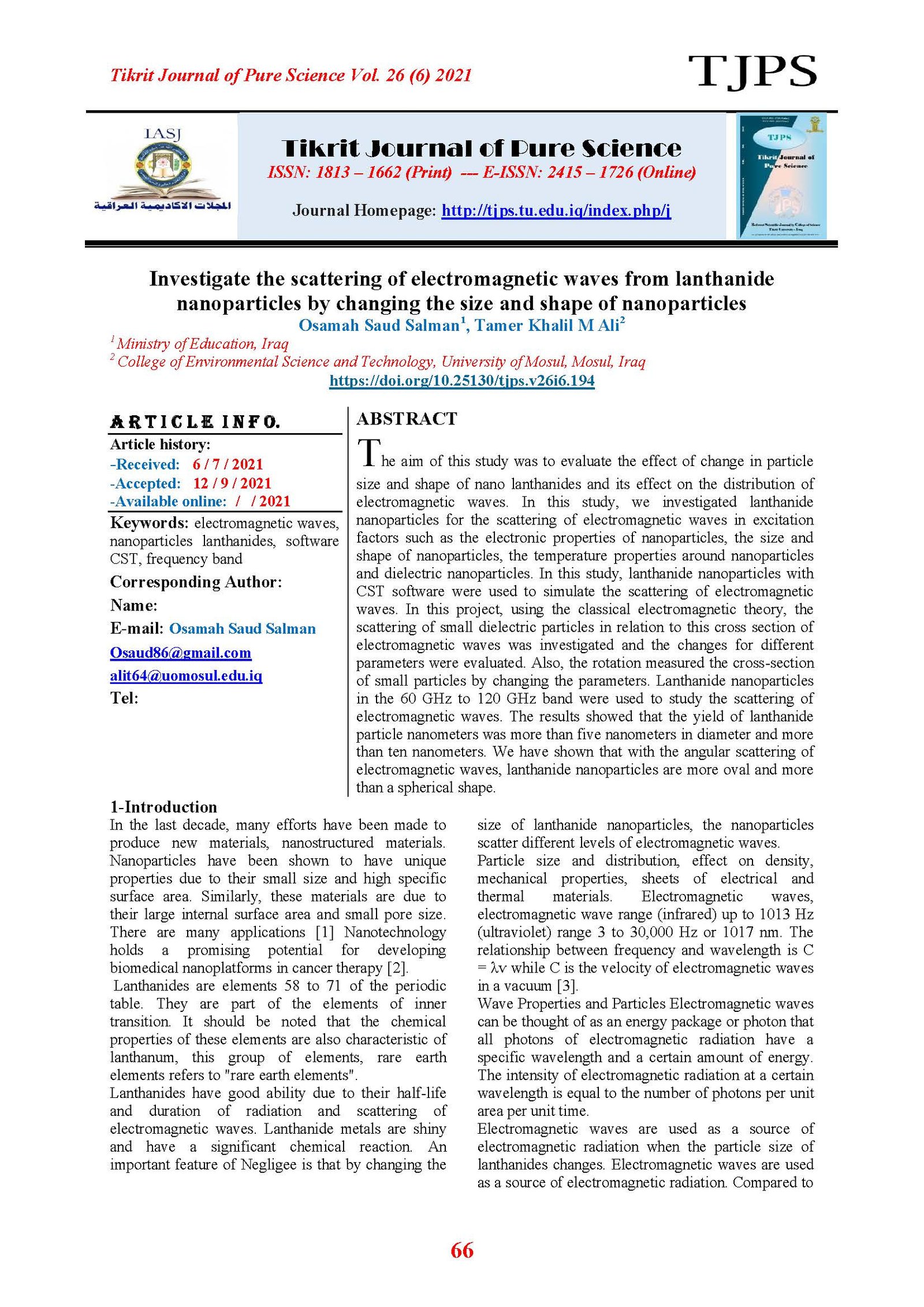Investigate the scattering of electromagnetic waves from lanthanide nanoparticles by changing the size and shape of nanoparticles
Main Article Content
Abstract
The aim of this study was to evaluate the effect of change in particle size and shape of nano lanthanides and its effect on the distribution of electromagnetic waves. In this study, we investigated lanthanide nanoparticles for the scattering of electromagnetic waves in excitation factors such as the electronic properties of nanoparticles, the size and shape of nanoparticles, the temperature properties around nanoparticles and dielectric nanoparticles. In this study, lanthanide nanoparticles with CST software were used to simulate the scattering of electromagnetic waves. In this project, using the classical electromagnetic theory, the scattering of small dielectric particles in relation to this cross section of electromagnetic waves was investigated and the changes for different parameters were evaluated. Also, the rotation measured the cross-section of small particles by changing the parameters. Lanthanide nanoparticles in the 60 GHz to 120 GHz band were used to study the scattering of electromagnetic waves. The results showed that the yield of lanthanide particle nanometers was more than five nanometers in diameter and more than ten nanometers. We have shown that with the angular scattering of electromagnetic waves, lanthanide nanoparticles are more oval and more than a spherical shape.
Article Details

This work is licensed under a Creative Commons Attribution 4.0 International License.
Tikrit Journal of Pure Science is licensed under the Creative Commons Attribution 4.0 International License, which allows users to copy, create extracts, abstracts, and new works from the article, alter and revise the article, and make commercial use of the article (including reuse and/or resale of the article by commercial entities), provided the user gives appropriate credit (with a link to the formal publication through the relevant DOI), provides a link to the license, indicates if changes were made, and the licensor is not represented as endorsing the use made of the work. The authors hold the copyright for their published work on the Tikrit J. Pure Sci. website, while Tikrit J. Pure Sci. is responsible for appreciate citation of their work, which is released under CC-BY-4.0, enabling the unrestricted use, distribution, and reproduction of an article in any medium, provided that the original work is properly cited.
References
[1] Davis ME, Zuckerman JE, Choi CHJ, Seligson D, Tolcher A, Alabi CA, et al.(2010). Evidence of RNAi in humans from systemically administered siRNA via targeted nanoparticles. Nature,46.
[2] H Zhang, XL Liu, YF Zhang, F Gao, GL Li, Y He.2018 . Magnetic nanoparticles based cancer therapy: current status and applications, Science China Life, - Springer …J Phys Chem 100, 13226–13239 .
[3] Ma X, Zhao Y, Liang X-J.(2011) Theranostic nanoparticles engineered for clinic and pharmaceutics. Accounts of Chemical Research. 44 (10): 1114–22.
[4] Agasti SS, Rana S, Park M-H, Kim CK, You C-C, Rotello VM.(2014). Nanoparticles for detection and diagnosis. Advanced Drug Delivery Reviews ; 62 (3): 316–28 .
[5] Medintz IL, Uyeda HT, Goldman ER, Mattoussi H.(2012). Quantum dot bioconjugates for imaging labelling and sensing. Nature Materials. ; 4 (6): 435–46.
[6] Zrazhevskiy P, Sena M, Gao X.(2013). Designing multifunctional quantum dots for bioimaging,
detection, and drug delivery. Chemical Society Reviews. 39 (11): 4326–54.
[7] Hilderbrand SA, Shao F, Salthouse C, Mahmood U, Weissleder R.(2009). Upconverting luminescent nanomaterials: Application to in vivo bioimaging. Chemical Communications. ; (28): 4188–90 .
[8] Mader HS, Kele P, Saleh SM, Wolfbeis OS.(2010) Upconverting luminescent nanoparticles for use in bioconjugation and bioimaging. Current Opinion in Chemical Biology. 14 (5): 582–96.
[9] Lee J-H, Huh Y-M, Jun Y, Seo J, Jang J, Song H-T, et al(2013). Artificially engineered magnetic nanoparticles for ultra-sensitive molecular imaging. Nature Medicine. 13 (1): 95–9ز
[10] M. F. Limonov, M. V. Rybin, A. N. Poddubny, and Y. S. Kivshar,(2017) “Fano resonances in photonics,” Nat. Photonics 11(9), 543–554 [CrossRef].
[11] M. Zhou, L. Ying, L. Lu, L. Shi, J. Zi, and Z. Yu,(2017) “Electromagnetic scattering laws in Weyl systems,” Nat. Commun. 8(1), 1388 [CrossRef] [PubMed].
[12] L. Ferrari, C. Wu, D. Lepage, X. Zhang, and Z. Liu, (2015) “Hyperbolic metamaterials and their applications,” Prog. Quantum Electron. 40, 1–40 . [CrossRef].
[13] L Hao, W Liu, K Liu, K Shan, C Wang, C Xi, J Liu, Q Fan… - Marine drugs, (2019)- mdpi.com In recent years, the wide application of exopolysaccharides (EPSs) in food, cosmetics, medicine, and other fields has drawn tremendous attention. In this study, an EPS produced by Pseudoalteromonas agarivorans Hao 2018 was isolated and purified, and its …
